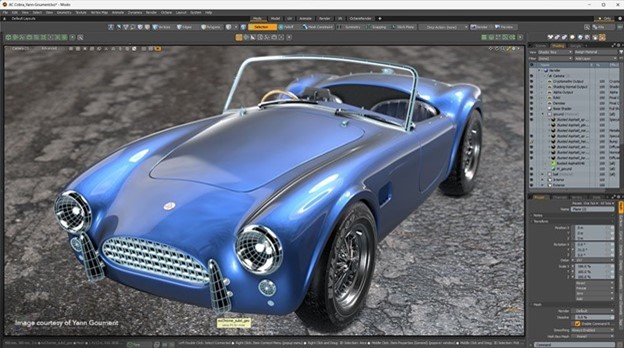Luxology entered the DCC market 20 years ago, forming around a brand-new software product called Modo. In no time, Modo developed a loyal following and was added to the pipelines of big-name studios and artists across the industry. Luxology continued to develop the software, and in 2012, it merged with the expanding Foundry. Modo’s developers came aboard, continuing their work with subsequent releases before eventually leaving. Modo was then left without an evangelist, particularly the passionate Brad Peebler, one of Modo’s original developers. And now, the industry will soon be left without Modo, as Foundry has announced the end of its support for the product.

What do we think? I recall when Modo and Luxology first stepped into industry. Its developers, including Brad Peebler, were well-respected in the industry for their work on the 3D modeling and animation software LightWave 3D. Peebler and other developers brought the same vision they had for LightWave to Modo—a powerful, efficient, reasonably-priced tool that reflected the tagline “created by artists for artists.” They were invested in the software, and their passion was evident. Sadly, passion, from development teams and users, is not enough to sustain a company or its product. Software development is a harsh master—just look at the number of DCC software offerings in the late 1990s versus today (a comprehensive look at the market can be found in JPR’s Digital Content Creation Report). While 3D content creation itself is at an all-time high, the business of 3D software development remains a difficult master.
After changing hands several years ago, Modo’s owner for the last dozen years, Foundry, is opting to pull the plug on Modo, calling the move a strategic business decision. No long, drawn-out death for Modo (though some might argue that its demise had been anticipated for years, despite a series of updates and releases under the new owners). There is yet one more new release around the corner, and then that’s it. Lights out. By the way, LightWave suffered a similar fate, but passion prevailed and passioned users and former associates moved to revive it, and under ownership, LightWave 2024 releases have begun. Perhaps the same might happen for Modo? Maybe, maybe not. Like we said earlier, 3D software development is a difficult business.
Luxology to release the last version of Modo
Modo, the sculpting, animation, texturing, and rendering software that offered digital content creators a unique solution from the standard DCC software of the day, began its industry ascent in the mid-2000s, gaining in popularity with each subsequent release. A merger between Luxology and Foundry followed several years later, but Modo never seemed to regain the strong footing it once had, nor will it ever again, as Foundry announced it is winding down development of the software.
Luxology introduced its modeling software, Modo, in August 2004, during Siggraph. It was then released the following month to a market that was already brimming with 3D modeling tools. But, Modo was unconventional and got attention. A sculpting tool, the software was lauded for its speed and efficiency, its flexibility, intuitive user interface, and easy-to-use tools capable of handling complex tasks compared to other 3D software at the time. Luxology continued to put its heart and soul into the software for several years, and then in September 2012, the company merged with Foundry, a VFX plug-in software company that had been gaining steam in the industry, especially after taking over development of the popular Nuke compositor in 2007 from Digital Domain (that particular path had its share of bumps and curves, but that is a story for another day).
When Modo popped onto the DCC scene in 2004, it did so with name recognition behind it—not in terms of the application itself, but because of the developers behind it: Stuart Ferguson, Allen Hastings, and Brad Peebler. They, along with several programmers, had left NewTek, which sold LightWave, following disagreements with company management over the software’s direction. LightWave’s users accounted for smaller percentage of the market compared to Autodesk’s Max and Maya modeling and animation software. However, make no mistake, those users were loyal and were attracted to LightWave’s out-of-the-box approach, with a fast rendering engine and advanced features. (There is a story behind that software’s history as well, but that is also for another time.)
With Modo, Luxology wanted a modern tool for the modern artist that provided an intuitive and fast workflow. Modo incorporated real-time subdivision surface and polygonal modeling capabilities and initially ran on Windows and macOS. Fresh out of the gate, Luxology, under the leadership of Peebler serving as president, highlighted the software’s “artist-driven workflow,” with interface elements like the Tool Pipe, which enables users to combine tools and their modifiers, create tool presets, and manage tool handle styles. The software also would feature customizable Action Centers for repositioning the center point of any editing command and falloffs.
Modo started out as a modeling application with an impressive, fast renderer. Built around a 3D operating system with a single code base, called Nexus, Modo could be extended into any area of 3D, including texturing and animation (which eventually happened).
It didn’t take long for Modo to win over users. In less than a year, it was integrated into VFX studio Digital Domain’s (Titanic, Benjamin Button) pipeline. Other big-name studios followed as well, including Pixar, ILM, Zoic, Eden FX, id Software, The Embassy, and others. Its popularity soared, and in 2006 the software received awards by various outlets including Apple, MacUser magazine, and Game Developer magazine.
Adding to the software’s attraction was its price. When it first shipped, Modo carried a price tag of $895, which was well below the cost of 3D Studio Max, as it was called then, as well as Maya and Softimage.
Soon, Modo acquired a significant number of users across broadcast VFX, gaming, CAD, advertising, and feature-film VFX and animation including Iron Man and Wall-E (both released in 2008). Luxology did not rest on its laurels, continuing to expand the software, praised for its ability to handle organic shapes, by adding robust 3D paint capabilities with the 200 series in 2006 and rendering improvements. The following year, Modo 301 was released, which added animation and a host of other capabilities. Subsequent releases continued to roll out with new or improved features.
In 2012, came the release of Modo 601—which, at the time, Peebler called it the company’s most significant release ever, with new features and workflow enhancements offering an end-to-end production solution. Then came the surprising news that Foundry had merged with Luxology. When the Luxology-Foundry merger was announced, Bill Collis, Foundry’s CEO at the time, pointed out how the two companies’s products were highly complementary and focused on openness and flexibility, letting users decide how they wanted to work.
Collis further noted that in the short term, the companies would continue working on the interaction between their products. Peebler expressed his optimism when the deal was announced, saying the merger would enable accelerated development of Modo. The good news was that Luxology’s senior management of Peebler, Ferguson, and Hastings retained operational responsibility for Modo, and Peebler was given president of the Americas for both companies, answering to Collis.
True to their word, substantial Modo releases continued for more than a decade after the deal. However, there were complaints regarding random crashes and performance issues on various online forums. Also, updates were slow compared to the competition’s software, something that did not go unnoticed by users. And when Blender introduced a significant update with Blender 2.8 (which is free, by the way) in 2019, especially with its modeling tools, it led to a further exodus of Modo users. It did not help, either, that Modo came across as a non-favored stepchild within the Foundry family. Sure, there were updates, and the software is currently at Version 17.0 and counting, but during press briefings at industry trade shows like Siggraph, it was mostly ignored. Perhaps that was due in part or more by Peebler’s exit from Foundry in September 2016, when he took his position as a director at Apple, which he currently still holds.

Jump ahead to a few days ago, when Foundry announced its decision to wind down development of Modo following the release of Modo 17.1 later this year, saying no new product releases (neither feature nor maintenance releases) are anticipated thereafter. Modo 17.0 launched in March 2024 with an overhauled core system, with Foundry billing the release as “the start of a new Modo,” and that “other releases would follow rapidly, consistently delivering to make Modo better throughout 2024.”
So, what happened to that goal? Foundry is saying very little.
On its website, the company stated, “This strategic decision will allow Foundry to focus on its core offerings and invest in new solutions that meet the evolving needs of the media and entertainment community.”
Those core offerings include Nuke, Katana, Ocula, Hiero, Mari, and Flix—all great, solid offerings, many of which have won coveted Academy Sci-Tech Awards, HPA Engineering Excellence Awards, and an Engineering Emmy.
Active Modo customers are being told they will continue to receive support until the end of their current contract and can obtain an extended 10-year license so that they can continue to use Modo in the future. Also, Modo product downloads, docs, learning content, and support knowledge base will be available until November 2025. The Modo forums, however, will be available only through December 2024.
The 3D software business is a tough one. There have been many mergers and acquisitions over the years, and some software thrives, while others struggle to survive. Still, the news of the pending demise of Modo marks the end of an era and an end to a 3D DCC software application that dared to break the mold. Modo, it was nice knowin’ ya.